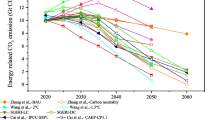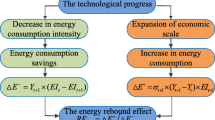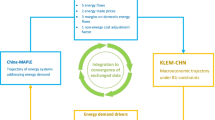Abstract
Low-carbon economic development and energy transition are interactively linked. The synergetic development of the two subsystems is important to achieve the “double carbon” goal of sustainable development. First, this study proposes a model to measure the current synergy level of China’s economy–energy low-carbon transition. Second, an optimization model is developed to improve industry and energy synergy levels through structure optimization. The synergy degree (SD) level of China’s economy–energy low-carbon transition increased from 0 to 0.98 between 2005 and 2017. Furthermore, 69.2% of the periods are in a state of asynergy (SD < 0.6). By implementing the industry and energy structure optimization (OPT) scenario, the synergy level by 2035 can be 27.8% higher than the business-as-usual (BAU) scenario. Moreover, light synergy (0.6 ≤ SD < 0.8) could be achieved by 2025, and high-quality synergy (0.9 ≤ SD ≤ 1) by 2033 in the OPT scenario. Conversely, the synergy level can only achieve light synergy until 2035 in the BAU scenario. Compared to energy structure optimization, the low carbonization of the economic structure plays a more significant role in improving the synergy level of the transaction. These findings can provide support for China’s policy-making regarding economic and energy transition.






Similar content being viewed by others
Data availability
The datasets used and/or analyzed during the current study are available from the corresponding author on reasonable request.
References
Acheampong AO, Boateng E, Amponsah M, Dzator J (2021) Revisiting the economic growth-energy consumption nexus: does globalization matter? Energy Econ 102. https://doi.org/10.1016/j.eneco.2021.105472
Ahmad M, Jan I, Jabeen G, Alvarado R (2021) Does energy-industry investment drive economic performance in regional China: implications for sustainable development. Sustain Prod Consum 27:176–192. https://doi.org/10.1016/j.spc.2020.10.033
An H, Razzaq A, Haseeb M, Mihardjo LWW (2021a) The role of technology innovation and people’s connectivity in testing environmental Kuznets curve and pollution heaven hypotheses across the Belt and Road host countries: new evidence from method of moments quantile regression. Environ Sci Pollut Res 28:5254–5270. https://doi.org/10.1007/s11356-020-10775-3
An H, Razzaq A, Nawaz A, Noman SM, Khan SAR (2021b) Nexus between green logistic operations and triple bottom line: evidence from infrastructure-led Chinese outward foreign direct investment in Belt and Road host countries. Environ Sci Pollut Res 28:51022–51045
Bridge G, Bouzarovski S, Bradshaw M, Eyre N (2013) Geographies of energy transition: space, place and the low-carbon economy. Energy Policy 53:331–340. https://doi.org/10.1016/j.enpol.2012.10.066
Chen Y, Liu S, Wu H, Zhang X, Zhou Q (2020) How can Belt and Road countries contribute to glocal low-carbon development? J. Cleaner Prod. 256:120717. https://doi.org/10.1016/j.jclepro.2020.120717
Cheng X, Long R, Chen H, Li Q (2019) Coupling coordination degree and spatial dynamic evolution of a regional green competitiveness system – a case study from China. Ecol Indic 104:489–500. https://doi.org/10.1016/j.ecolind.2019.04.003
Chien F, Anwar A, Hsu C-C, Sharif A, Razzaq A, Sinha A (2021) The role of information and communication technology in encountering environmental degradation: proposing an SDG framework for the BRICS countries. Technol Soc 65:101587. https://doi.org/10.1016/j.techsoc.2021.101587
Chishti MZ, Sinha A (2022) Do the shocks in technological and financial innovation influence the environmental quality? Evidence from BRICS economies. Technol Soc 68:101828. https://doi.org/10.1016/j.techsoc.2021.101828
Danish, Wang Z (2019) Investigation of the ecological footprint’s driving factors: what we learn from the experience of emerging economies. Sustainable Cities and Society 49:101626. https://doi.org/10.1016/j.scs.2019.101626
Dong C (2018) The collaborative optimization of the industrial structure and the energy structure in China under the carbon emission reduction targets of the Paris Agreement. Doctor Thesis, China University of Petroleum,Beijing
Dong K (2009) The dynamic optimization model of industrial structure with energy-saving and emission-reducing constraint. Journal of Sustainable Development 1:27
Fragkos P, Tasios N, Paroussos L, Capros P, Tsani S (2017) Energy system impacts and policy implications of the European Intended Nationally Determined Contribution and low-carbon pathway to 2050. Energy Policy 100:216–226
Fragkos P et al (2021) Energy system transitions and low-carbon pathways in Australia, Brazil, Canada, China, EU-28, India, Indonesia, Japan, Republic of Korea Russia and the United States. Energy 216:119385. https://doi.org/10.1016/j.energy.2020.119385
Guan D, Meng J, Reiner DM, Zhang N, Shan Y, Mi Z (2018) Structural decline in China’s CO2 emissions through transitions in industry and energy systems. Nat Geosci 11(8):551–555. https://doi.org/10.1038/s41561-018-0161-1
Haken H (1977) Synergetics. Phys Bull 28:412–414. https://doi.org/10.1088/0031-9112/28/9/027
Haken H (1983) Synergetics: an introduction. Springer Verlag Berlin New York -1
Hansen U (1990) Delinking of energy consumption and economic growth: the German experience. Energy Policy 18:631–640. https://doi.org/10.1016/0301-4215(90)90080-N
Hosan S, Karmaker SC, Rahman MM, Chapman AJ, Saha BB (2022) Dynamic links among the demographic dividend, digitalization, energy intensity and sustainable economic growth: empirical evidence from emerging economies. J Clean Prod 330:129858. https://doi.org/10.1016/j.jclepro.2021.129858
Humphrey WS, Stanislaw J (1979) Economic growth and energy consumption in the U.K., 1700–1975. Energy Policy 7:29–42. https://doi.org/10.1016/0301-4215(79)90049-1
Jiang B, Sun Z, Liu M (2009) China’s energy development strategy under the low-carbon economy. Energy 35
Jin L, Chang Y-h, Wang M, Zheng X-z, Yang J-x, Gu J (2022) The dynamics of CO2 emissions, energy consumption, and economic development: evidence from the top 28 greenhouse gas emitters. Environ Sci Pollut Res. https://doi.org/10.1007/s11356-021-18069-y
Kraft J, Kraft A (1978) On the relationship between energy and GNP.
Kroll C, Warchold A, Pradhan P (2019) Sustainable Development Goals (SDGs): are we successful in turning trade-offs into synergies? Palgrave Commun 5:140. https://doi.org/10.1057/s41599-019-0335-5
Leontief WW (1936) Quantitative input and output relations in the economic systems of the United States. Rev Econ Stat 18:105–125. https://doi.org/10.2307/1927837
Li H, Chen L (2019) Measurement on regional service trade and ecological environment coordination. Statistics and Decision 35:101-104. https://doi.org/10.13546/j.cnki.tjyjc.2019.05.022
Liu J, Tian Y, Huang K, Yi T (2021a) Spatial-temporal differentiation of the coupling coordinated development of regional energy-economy-ecology system: a case study of the Yangtze River Economic Belt. Ecological Indicators 124:107394. https://doi.org/10.1016/j.ecolind.2021a.107394
Liu P, Gao P, Liu Q (2021) External orderliness-synergy of electric power industry in Yangtze River Delta during energy transition period. Journal of Cleaner Production 280:124381. https://doi.org/10.1016/j.jclepro.2020.124381
Liu Y (2018) Regional economic synergistic development: the new path of regional economic growth in China. Doctor Thesis, Hunan University(In Chinese)
Liu Z et al (2015) Reduced carbon emission estimates from fossil fuel combustion and cement production in China. NATURE 524, 335-+.https://doi.org/10.1038/nature14677
Lu S, Wang J, Shang Y, Bao H, Chen H (2017) Potential assessment of optimizing energy structure in the city of carbon intensity target. Appl Energy 194:765–773. https://doi.org/10.1016/j.apenergy.2016.07.116
Mu X, Kong L, Tu C, Chen J, Hu G (2021) Correlation and synergy analysis of urban economy–energy–environment system—a case study of Beijing. Nat Resour Model e12329
NDRC (2014) National climate change plan (2014–2020), Beijing
NDRC, NEA (2016a) The Revolution Strategy for Energy Production and Consumption (2016a–2030), Beijing
NDRC, NEA (2016b) The 13th Five-Year Plan for Energy Development, Beijing
Rahman MM, Velayutham E (2020) Renewable and non-renewable energy consumption-economic growth nexus: new evidence from South Asia. Renew Energy 147:399–408. https://doi.org/10.1016/j.renene.2019.09.007
Razzaq A, Sharif A, Najmi A, Tseng M-L, Lim MK (2021) Dynamic and causality interrelationships from municipal solid waste recycling to economic growth, carbon emissions and energy efficiency using a novel bootstrapping autoregressive distributed lag. Resour Conserv Recycl 166:105372. https://doi.org/10.1016/j.resconrec.2020.105372
Ren F, Yu X (2021) Coupling analysis of urbanization and ecological total factor energy efficiency —— a case study from Hebei province in China. Sustain Cities Soc 74:103183. https://doi.org/10.1016/j.scs.2021.103183
Santiago R, Fuinhas JA, Marques AC (2020) The impact of globalization and economic freedom on economic growth: the case of the Latin America and Caribbean countries. Econ Change Restruct 53:61–85. https://doi.org/10.1007/s10644-018-9239-4
SC (2021) Circular of the State Council on the issuance of an action plan to peak carbon emissions by 2030. In: China tSCotPsRo (Hrsg.)
Shi HT, Chai J, Lu QY, Zheng JL, Wang SY (2022) The impact of China’s low-carbon transition on economy, society and energy in 2030 based on CO2 emissions drivers. Energy 239. https://doi.org/10.1016/j.energy.2021.122336
Su B, Ang BW (2015) Multiplicative decomposition of aggregate carbon intensity change using input–output analysis. Appl Energy 154:13–20
Tan F, Kong Q (2020) Uncovering the driving mechanism of regional synergistic development based on Haken model: case of the Bohai Rim region. Environ Dev Sustain 22:3291–3308. https://doi.org/10.1007/s10668-019-00346-z
Tang Z, Shi CB, Liu Z (2011) Sustainable development of tourism industry in China under the low-carbon economy. Energy Procedia 5:1303–1307
Toh M-H (1998) The RAS approach in updating input–output matrices: an instrumental variable interpretation and analysis of structural change. Econ Syst Res 10(1):63–78. https://doi.org/10.1080/09535319800000006
Tomal M (2021) Evaluation of coupling coordination degree and convergence behaviour of local development: a spatiotemporal analysis of all Polish municipalities over the period 2003–2019. Sustain Cities Soc 71:102992. https://doi.org/10.1016/j.scs.2021.102992
Ucal M, Xydis G (2020) Multidirectional relationship between energy resources, climate changes and sustainable development: technoeconomic analysis. Sustain Cities Soc 60:102210. https://doi.org/10.1016/j.scs.2020.102210
Waheed R, Sarwar S, Wei C (2019) The survey of economic growth, energy consumption and carbon emission. Energy Rep 5:1103–1115. https://doi.org/10.1016/j.egyr.2019.07.006
Wang S, Song J, Wang XE, Yang W (2019) The spatial and temporal research on the coupling and coordinated relationship between social economy and energy environment in the Belt and Road Initiatives. Sustainability 11:407
Wang T, Watson J (2010) Scenario analysis of China’s emissions pathways in the 21st century for low carbon transition. Energy Policy 38
Wang X, Song J, Duan H (2021) Coupling between energy efficiency and industrial structure: an urban agglomeration case. Energy 234:121304
Wang Y, Zhao H, Li L, Liu Z, Liang S (2013) Carbon dioxide emission drivers for a typical metropolis using input–output structural decomposition analysis. Energy Policy 58:312–318
Wang Y, Fang X, Yin S, Chen W (2021) Low-carbon development quality of cities in China: evaluation and obstacle analysis. Sustainable Cities and Society 64:102553. https://doi.org/10.1016/j.scs.2020.102553
Weimin Z, Zubair Chishti M (2021) Toward sustainable development: assessing the effects of commercial policies on consumption and production-based carbon emissions in developing economies. SAGE Open 11:21582440211061580. https://doi.org/10.1177/21582440211061580
Wen Y, Cai B, Yang XX, Xue YS (2020) Quantitative analysis of China’s low-carbon energy transition. Int J Electr Power Energy Syst 119. https://doi.org/10.1016/j.ijepes.2020.105854
Xi JP (2020) Carry forward the past and forge ahead into the future and start a new journey of global response to climate change - speech at the Climate Ambition Summit. xinhuanet, Beijing
Xia Y, He G (2018) Measurement of synergy between China’s scientific and technological innovation and industrial upgrading. Science and Technology Management Research 38, 27–33(in Chinese). https://doi.org/10.3969/j.issn.1000-7695.2018.08.004
Xin-gang Z, Jin Z (2022) Industrial restructuring, energy consumption and economic growth: evidence from China. J Cleaner Prod 335:130242. https://doi.org/10.1016/j.jclepro.2021.130242
Xinhua (2017) China’s oil and gas development will enter the “deep water” stage, Beijing
Yu F (2015) Research on coordinative development between economy and energy in China. Industrial Technology & Economy, 60–69(In Chinese).https://doi.org/10.3969/j.issn.1004-910X.2015.01.007
Yu S, Zheng S, Li X (2018a) The achievement of the carbon emissions peak in China: the role of energy consumption structure optimization. Energy Econ 74:693–707
Yu S, Zheng S, Li X, Li L (2018b) China can peak its energy-related carbon emissions before 2025: evidence from industry restructuring. Energy Econ 73:91–107
Yu S, Zheng S, Zhang X, Gong C, Cheng J (2018c) Realizing China’s goals on energy saving and pollution reduction: industrial structure multi-objective optimization approach. Energy Policy 122:300–312
Yu S, Zhou S, Zheng S, Li Z, Liu L (2019) Developing an optimal renewable electricity generation mix for China using a fuzzy multi-objective approach. Renew Energy 139:1086–1098. https://doi.org/10.1016/j.renene.2019.03.011
Zeng X, Xiang H, Xue Y, Su Y, Tong Y, Mao Z (2021) A scenario-based optimization frame to adjust current strategy for population- economy-resource-environment harmony in an urban agglomeration China. Sustain Cities Soc 67:102710. https://doi.org/10.1016/j.scs.2021.102710
Zhang H, Razzaq A, Pelit I, Irmak E (2021) Does freight and passenger transportation industries are sustainable in BRICS countries? Evidence from advance panel estimations. Economic Research-Ekonomska Istraživanja 1–21. https://doi.org/10.1080/1331677X.2021.2002708
Zhao F, Zhang W, Wang Y (2016) Quantifying the coordination of energy development and environmental protection: a case study of China. Energy Procedia 104
Zhou J, Li J (2011) Analysis on the relationship between China’s energy consumption structure and industrial structure. Seek and Explore, 42–44(In Chinese).CNKI:SUN:QSZZ.0.2011–12–014
Funding
This study was supported by the National Natural Science Foundation of China (Nos. 72174188, 31961143006, and 71822403) and Hubei Natural Science Foundation, China (No. 2019CFA089).
Author information
Authors and Affiliations
Contributions
Shiwei Yu: conceptualization, writing—original draft, review and editing, project administration. Jiahui Liu: methodology, analysis, writing—original draft. Shuangshuang Zhou: analysis, methodology writing—review and editing.
Corresponding author
Ethics declarations
Ethics approval
Not applicable.
Consent to participate
Not applicable.
Consent for publication
Not applicable.
Competing interests
The authors declare no competing interests.
Additional information
Responsible Editor: Arshian Sharif
Publisher's note
Springer Nature remains neutral with regard to jurisdictional claims in published maps and institutional affiliations.
Appendix
Appendix
Rights and permissions
About this article
Cite this article
Yu, S., Liu, J. & Zhou, S. Synergy evaluation of China’s economy–energy low-carbon transition and its improvement strategy for structure optimization. Environ Sci Pollut Res 29, 65061–65076 (2022). https://doi.org/10.1007/s11356-022-20248-4
Received:
Accepted:
Published:
Issue Date:
DOI: https://doi.org/10.1007/s11356-022-20248-4




